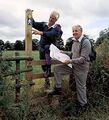Ramblers
The Ramblers Association is a popular activity among the pensioner population of England and Wales, and boasts in excess of 14,000,000 members.
Vast herds may be seen roaming the countryside on Sunday morning. The rambler can often be identified by the matching scarf and bobble hat, in colours never sported by any football team, plus trousers tucked into socks to stop them from getting muddy.
Parsimony[edit]
Doddering over England's Municipal Garden Centres and valley groins, weighed down by a bewildering ballast of advanced infirmity, the Rambler is, after Scrumpers, Poachers and Gypsies Great Britain's most familiar trespasser.[1]
It is a known fact that ramblers never like to pay for anything, so walks start from the limited number of locations which offer free parking for large numbers of cars. Typically these are car parks outside council offices and libraries, which are closed on Sundays.
A Little Old Lady Goes Rambling[edit]
Offering one frail foot to the air directly in front of it's partner with shy politeness indicative of an addled mind, then at length lowering the foot till touching earth and repeating the act in mirror image, the little old lady after a fashion trembles-forth into the aggressively blinding daylight, eyes watery with a sop-headed optimism.
Then suddenly slipping in a swooping hip-shatterer she assaults the ground face first!!!
Lying like a pummelled schlub hidden from view by her own garden gnome, the lady's brain eeks outs a meritless trickle of information that will incrementally convert her currently pervasive state of confusion into that of white-hot shock. But what's this? A travelling salesman snickering like a snake among the bungalows, sniffing out his prey, skips over her garden wall to pinch the gnome before continuing on his merry way, leaving behind the still prostrate ex-rambler[2] to be sneered at by the neighbourhood.
Organisation[edit]
Ramblers have an obsessive appetite for organisation. Walks are led by an officially appointed Walks Leader, who has to attend a lengthy and comprehensive series of courses organised by the Association on map-reading, basic first aid and crowd control. The Walks Leader is easily identified by the assortment of paraphernalia hanging from cords around his neck. This usually includes maps in transparent cases, a compass, GPS and a whistle. The Walks Leader is usually assisted by the back marker, whose task it is to chivvy along the stragglers, and keep the Walks Leader regularly informed about the current location of the back of the party on his mobile phone. The back marker is also responsible for ensuring that gates are shut after the party has passed by, and for picking up any litter. The Walks Leader will stop the walk to allow the stragglers to catch up if they get too far behind. The Walks Leader also usually has an assistant with a clicker counter, to make sure that the entire party has been accounted for each time the walk comes to a halt.
Ramblers groups are often sufficiently numerous to be able to offer A, B, and C walks. The C walks are usually less than 5 miles, for the most unfit and decrepit walker. A B walk is a little more, typically 7 or 8 miles. An A walk may reach as much as 10 miles, although it is to be admitted that this is rarely achievable due to the frequent halts required by a large organised group. New members are obliged to join the C walks and are only permitted to graduate to the B and eventually the A walks once the Committee is convinced that their level of physical fitness merits promotion.
Most groups also organise midweek walks, for members for whom the Sunday morning excursion does not present sufficient excitement.
It is a known fact that the majority of ramblers spent their working lives as minor civil servants, and their civil service training is reflected in the glacial progress of promotion up the rankings. From induction as a new member on the C walks to fully qualified Walks Leader will usually take at least a couple of decades.
Your Local Ramblers Group[edit]
Local groups of the Ramblers Association are organised around local council districts. This is practically unique for an organisation based on voluntary membership. The local secretary of the group is invariably intimately conversant with the district boundaries, and interlopers from outside the boundary will be informed that they must join their own group. Disputes occasionally arise when council boundaries change, as members have to be transferred from one group to another, and their new group receive a proportion of the subscriptions paid.
Although the Ramblers have absolutely no influence on government policy on public access in the countryside, or any other activity to speak of, there is a complicated hierarchy of committees above the local groups, from counties and regions up to the salaried executive in London. Many committed committee activists are in fact so busy that they have not had time to go for a walk for years.
The increasing median age of the Ramblers’ membership has been a constant concern to the hierarchy in London, who fear that their jobs may eventually be at risk if the death rate of older members exceeds the pace of new recruitment. Considerable effort has been made in recent years to the establishment of younger Ramblers’ groups, on the same model as the familiar senior group. The Ramblers’ house journal has also received a make over and its’ content and presentation now closely resembles its commercial counterparts such as Trail Walking.
People who actually live in the countryside do not join the Ramblers. In fact most people who live in the country hate the Ramblers. This is probably because most Ramblers are middle-class incomers who move to the country and join the Ramblers when they retire.
Some facts about Ramblers[edit]
- 86% of Ramblers are scared of cows. In fact the average pensioner will manage a 100 yard dash for the nearest gate in under 10 seconds if approached by an over-curious bovine.
- 90% of Ramblers sport the old fashioned type of glass vacuum flask when the group stops for refreshments. This is the type that originally came in a wickerwork picnic basket set, and usually has a tartan pattern printed on the outside. Some Ramblers even bring along the plastic plates and cutlery which came with these sets on their walks.
- 96% of Ramblers experience difficulty in easing ageing and arthritic limbs over stiles. Most local groups have ongoing campaigns to persuade local councils to spend precious funds on replacing perfectly serviceable stiles and kissing gates.
- 99.8% of Ramblers are profoundly ignorant about the countryside and cannot identify common makes of tractor, agricultural machinery, tree species or breeds of cattle and sheep. Most Ramblers will confuse a cow with horns for a bull.
- 99.8% of Ramblers cannot read maps. The Ordnance Survey's products feature extremely small print and fine detail, and this causes problems for people whose eyesight is not as keen as it used to be.
Famous Ramblers[edit]
Famous Ramblers include Victor Meldrew, and err... The bearded minor celebrity mountaineer Cameron MacNeish is Vice-President of the Scottish Ramblers Association. The present size of his midriff however suggests that he has not actually climbed a mountain for years. Onetime yoof slebrity television presenter and risible mockney Janet Street Porter really shows her age now that she is a former president of the Ramblers.





